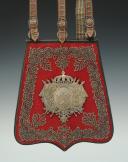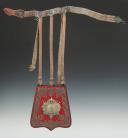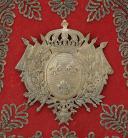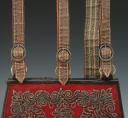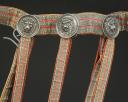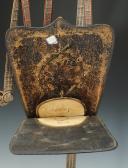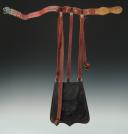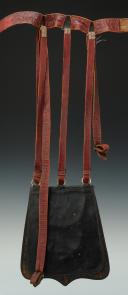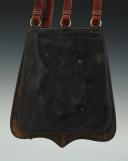
Sabretache of Sub-Lieutenant Legay from the Hussars of the Royal Guard, Restoration period (1816-1830).
Sold out
SABRETACHE BELONGING TO LIEUTENANT LEGAY OF THE HUSSARS OF THE ROYAL GUARD, Restoration period (1816-1830).
Black waxed leather sabretache, flap covered with crimson cloth adorned at its center with a solid silver plaque hallmarked (illegible hallmark) depicting the Arms of France framed by an oak and laurel branch with the Order of the Holy Spirit attached, all resting on a bundle of flags. Height of the plaque 15.5 cm, width 14 cm. The outer edge of the flap is trimmed with flat silver passementerie trim forming numerous volutes to simulate a braid, average width 3.5 cm. At the top, three silver rings (diameter 2.9 cm, thickness 4 mm) are attached by varnished leather straps.
Maximum height of the flap 32 cm. Width at the top 20.4 cm and 28.4 cm at the bottom.
The central plaque is attached to the flap by eight tabs. The sabretache pocket is made of black varnished leather, height 28 cm, width at the top 20 cm and 24.5 cm at the bottom. It is lined with calf leather, marked with the name "LEGAY" in ink, and bears the stamp of the Paris exhibition as well as the number "300177."
Sword belt and sabretache holder entirely in Bordeaux maroquin, composed of a 4.2 cm wide belt covered with silver passementerie braid with two crimson silk strands. This part is embellished with five round solid silver buckles (diameter 4.7 cm) decorated with a lion's head in the center of each. The two central buckles are connected with an S-shaped hook. Two sword suspension straps are also attached to the belt, 3 cm wide, lengths of 40 cm and 79 cm, ending with an oval silver buckle (height 3.7 cm, width 3.1 cm). Three sabretache suspension straps, similarly finished on the belt (width 2.1 cm, length 45 cm), ending with an oval silver buckle (height 3.1 cm, width 2.7 cm).
France.
Restoration period (1816-1830).
Very good condition, some oxidation on the trimmings and braids, some repairs on the cloth of the flap.
BIOGRAPHY:
Lieutenant Legay, a Legion of Honor officer, joined the regiment of the Hussars of the Royal Guard on January 23, 1821. He remained in the corps at the same rank until 1828.
PROVENANCE:
Former collection of Dr. Henri Polaillon, born in 1875 in Paris, the only son of a family of Lyon doctors and surgeons. His father, Benjamin Polaillon, was a surgeon at the hospitals of Paris and a member of the Academy of Medicine. Dr. Polaillon, a graduate of the Paris faculty of Medicine, demonstrated his interest in natural sciences with his first thesis in 1901 titled "Contribution to the study of the natural and medical history of mosquitoes." He became a full member of the Zoological Society of Paris in 1902. In 1910, he married Louise Mollier-Carroz, the granddaughter of Professor Félix Guyon, the renowned founder of modern urology. After the Great War, he devoted himself entirely to his passion for collecting, as evidenced by his eclectic library comprising literature, botany, natural sciences, medicine, numismatics, and finally, weapons and mementos of the First Empire. "Dr. Polaillon, the amiable and erudite collector, whose opinions were authoritative in matters of edged weapons" (according to La Sabretache), passed away in 1941.
Black waxed leather sabretache, flap covered with crimson cloth adorned at its center with a solid silver plaque hallmarked (illegible hallmark) depicting the Arms of France framed by an oak and laurel branch with the Order of the Holy Spirit attached, all resting on a bundle of flags. Height of the plaque 15.5 cm, width 14 cm. The outer edge of the flap is trimmed with flat silver passementerie trim forming numerous volutes to simulate a braid, average width 3.5 cm. At the top, three silver rings (diameter 2.9 cm, thickness 4 mm) are attached by varnished leather straps.
Maximum height of the flap 32 cm. Width at the top 20.4 cm and 28.4 cm at the bottom.
The central plaque is attached to the flap by eight tabs. The sabretache pocket is made of black varnished leather, height 28 cm, width at the top 20 cm and 24.5 cm at the bottom. It is lined with calf leather, marked with the name "LEGAY" in ink, and bears the stamp of the Paris exhibition as well as the number "300177."
Sword belt and sabretache holder entirely in Bordeaux maroquin, composed of a 4.2 cm wide belt covered with silver passementerie braid with two crimson silk strands. This part is embellished with five round solid silver buckles (diameter 4.7 cm) decorated with a lion's head in the center of each. The two central buckles are connected with an S-shaped hook. Two sword suspension straps are also attached to the belt, 3 cm wide, lengths of 40 cm and 79 cm, ending with an oval silver buckle (height 3.7 cm, width 3.1 cm). Three sabretache suspension straps, similarly finished on the belt (width 2.1 cm, length 45 cm), ending with an oval silver buckle (height 3.1 cm, width 2.7 cm).
France.
Restoration period (1816-1830).
Very good condition, some oxidation on the trimmings and braids, some repairs on the cloth of the flap.
BIOGRAPHY:
Lieutenant Legay, a Legion of Honor officer, joined the regiment of the Hussars of the Royal Guard on January 23, 1821. He remained in the corps at the same rank until 1828.
PROVENANCE:
Former collection of Dr. Henri Polaillon, born in 1875 in Paris, the only son of a family of Lyon doctors and surgeons. His father, Benjamin Polaillon, was a surgeon at the hospitals of Paris and a member of the Academy of Medicine. Dr. Polaillon, a graduate of the Paris faculty of Medicine, demonstrated his interest in natural sciences with his first thesis in 1901 titled "Contribution to the study of the natural and medical history of mosquitoes." He became a full member of the Zoological Society of Paris in 1902. In 1910, he married Louise Mollier-Carroz, the granddaughter of Professor Félix Guyon, the renowned founder of modern urology. After the Great War, he devoted himself entirely to his passion for collecting, as evidenced by his eclectic library comprising literature, botany, natural sciences, medicine, numismatics, and finally, weapons and mementos of the First Empire. "Dr. Polaillon, the amiable and erudite collector, whose opinions were authoritative in matters of edged weapons" (according to La Sabretache), passed away in 1941.
Reference :
19440/21043
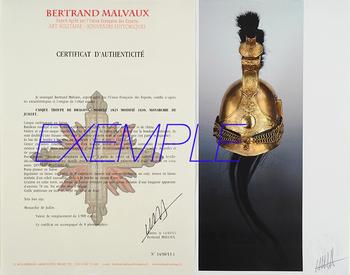
Next update Friday, april 4th at 1:30 PM
FOR ALL PURCHASES, PAYMENT IN MULTIPLE CHECKS POSSIBLE
bertrand.malvaux@wanadoo.fr 06 07 75 74 63
An authenticity certificate of the item including the description published on the site, the period, the sale price, accompanied by one or more color photographs is automatically provided for any item priced over 130 euros. Below this price, each certificate is charged 5 euros.
Only items sold by me are subject to an authenticity certificate, I do not provide any expert reports for items sold by third parties (colleagues or collectors).
